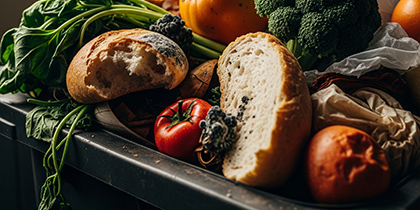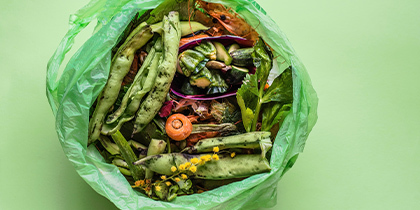Worldwide, 1.05 billion tons of food are thrown away each year. The figures are also high in the Netherlands and Belgium: in the Netherlands, it is over 2 billion kilos per year. In Belgium, it amounts to an average of 345 kilos per person annually. This waste occurs everywhere: in supermarkets, restaurants, at home and on the shop floor.
At Milgro, we work daily to prevent (food) waste - both with our partners and on our own work floor. How do we do that? You can read about it in this blog.
The Wastefree Week is organized by the Foundation Together Against Food Waste. The goal is to make people aware of how much food is thrown away unnecessarily.
Preventing food waste starts with purchasing
That's why at Milgro's office we only buy what we really need. Do we organize a lunch at the office? Then we adjust the quantities to the number of colleagues present. This prevents unnecessary food waste. Is there anything left over? Then we put it in the canteen, so that colleagues can still grab it later in the day.
We also buy our fruit and vegetables from a local farmer. By doing so, we not only support local.jpg?width=223&height=223&name=LinkedIn%20(73).jpg)
entrepreneurs, but also reduce the number of transport movements - and thus CO₂ emissions. An additional advantage is that local farmers often do not pack the fruit and vegetables in packaging material - like the net around the tangerines from the supermarket.
Conscious purchasing choices not only help prevent food waste, but also reduce packaging waste and CO2 emissions, for example.
Food waste in the canteen
In Europe, approximately 12% of all food waste comes from the food service sector - think of restaurants, catering and company canteens.
restaurants, catering and company canteens. To prevent food waste at Milgro's office, we use date tags for all products that employees bring for lunch. Do you put something in the refrigerator? Then stick a card on it with your name and expiration date. That way we know who it belongs to and can remind the person if necessary, so it gets eaten on time and doesn't have to be thrown away unnecessarily.
Is the card missing? Then we first ask around who the product belongs to. Do we not know? Then we move it to the general refrigerator. There it can - if it still has a shelf life - still be used, for example for lunch.
What do we do with products that are past their sell-by date?
Is the product expired? Then it goes into our worm hotel. Worm composting - also called vermicomposting - is a method of composting in which compost worms convert vegetable and fruit scraps into compost. These worms live just below the soil surface and specialize in digesting fresh organic waste.
In a specially designed worm hotel, the worms eat vegetable and fruit scraps. What they excrete is a fine, crumbly compost rich in nutrients for plants and soil. Thus, organic waste is given a new function as compost, instead of ending up as residual waste.
Reducing food waste in the food industry
At Milgro, we are committed to reducing food waste not only during Wastefree Week - but throughout the year. We do this not only on our own shop floor, but also in cooperation with our partners.
A clear example is at one of our partners in the food industry. A large quantity of rejected chips arose daily at the company site-among other things due to packaging errors, production surpluses or products that did not meet the quality standard. The chips were often still in the original bags and went straight into the container, where they were disposed of as residual waste.
The result: a dumpster full of chip bags. Because the packaging could not be compressed,
the container filled up quickly and had to be emptied frequently - even though it contained relatively few kilograms of waste.
Working with Milgro, the analysis examined how we could keep this waste stream as a raw material, rather than ending up as residual waste. The solution chosen: a shredder that reduces the chips directly at the source.
This provided two benefits. Because the chips were shredded separately from their packaging, they could be safely used as animal feed - without mixing with packaging material. This gave the stream a new function within the chain and preserved valuable raw materials.
Whereas previously the waste container had to be emptied frequently because the chips in their packaging took up a lot of volume, reducing the size of the chips means that significantly more fits into the same container. That means less transport - and therefore less CO₂ emissions.

Wondering what we can do for your organization
Schedule a no-obligation meeting with
Alex van Kuilenburg, Team Lead Food at Milgro.
Staying uptodate
Want to stay up to date on all new developments? Follow us on LinkedIn, listen to the podcast 'Grondstof tot nadenken' or subscribe to the newsletter. Are you curious about what Milgro can do for your business and waste process? Then get in touch.










